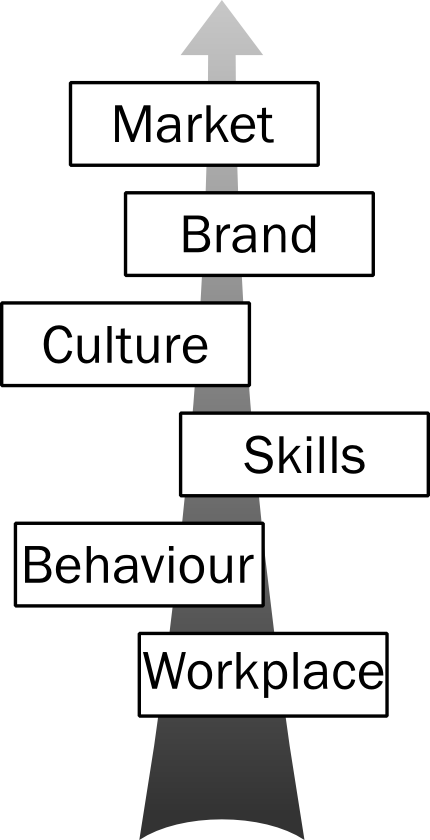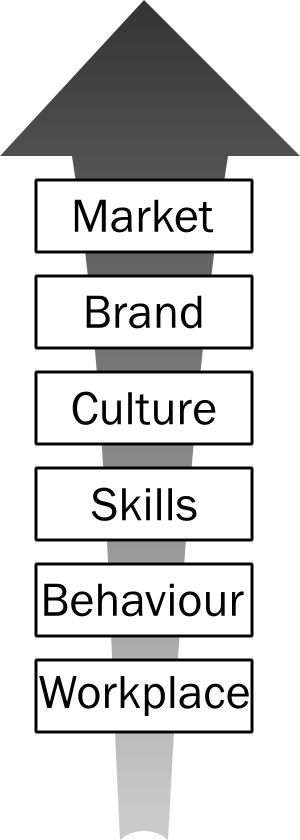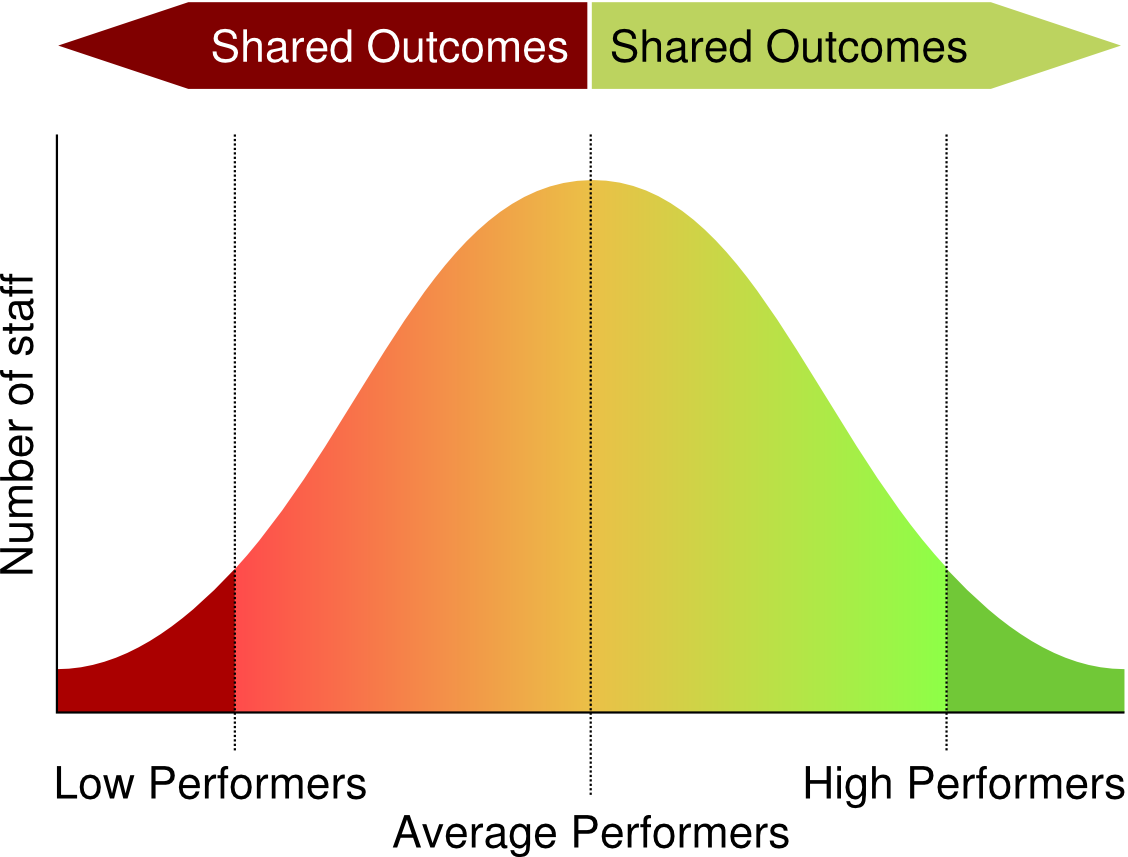Typically, any organisation or team has a number of high performers who consistently outperform the average. It is becoming increasingly common that organisations have two sets of measurement criteria; explicit, task focused criteria such as sales targets and customer service metrics, and implicit, cultural criteria such as attitude, working environment and customer experience.
It is not enough to simply benchmark performance, because that benchmark is a static measurement in a changing environment. Managers often say that they have to “run to stand still” in a fast changing business environment, and part of the problem is the use of static performance benchmarks which give the illusion that the environment is changing.
In fact, it is easier to harness and direct this natural momentum for change than to create change based on an illusion of inertia.
By analysing a person’s ability to get a certain result within a cultural system, we are able to discover not only the person’s intuitive behaviour but also the cultural system within which that behaviour works best.
It is very common for companies to hire ‘star players’ such as high performing sales people and executives, only to find that they do not perform as expected. There was nothing wrong with the person, they were simply used to working within a different set of rules. Some people, over time, will learn the new rules and adapt to them, some will not.
Often, ‘culture change’ programmes are introduced at the development stage of the people cycle, by sending people on training courses to learn new organisational values. The problem with this is that it is rarely tied into the other parts of the people cycle – attraction and retention – so over time, the ‘new’ culture works its way out of the system, and the incumbent culture is preserved.
Culture change can be viewed as a natural process of evolution which is itself a learned adaptation to a changing environment. If your business environment is evolving, you need to evolve with it, supporting people at all stages of the people cycle at the same time. By changing the way you attract new people, those people will evolve the culture iteratively and systemically. In the long term, this creates a stable organisation, but it does require commitment and consistency of business strategy, because it will take a year or two for the new cultural rules and beliefs to become ‘the way we do things around here’. Also, this is not a one off process. It is important to be constantly adapting and evolving as the market evolves. When companies only run change projects when the gap between their behaviour and the market environment is so big that profits start to fall, it is already too late.
So in modelling high performers and using that information to align the people cycle behind a vision and business plan, the result is greater alignment of the culture and the people within it. The result of this is that more of each individual’s time, energy and commitment is focused on realising that vision.
 The diagram to the left illustrates a poorly aligned organisation, where many people feel frustration as a result of being unable to contribute and make positive changes. Effort is wasted, re-organisations are common and, ultimately, people will disengage and do the minimum that they can.
The diagram to the left illustrates a poorly aligned organisation, where many people feel frustration as a result of being unable to contribute and make positive changes. Effort is wasted, re-organisations are common and, ultimately, people will disengage and do the minimum that they can.
Frustration is the feeling that forms when a person’s desire to achieve a goal is blocked or hindered by a barrier which is not under their control.
This situation leads to small effects on a day to day basis, and those daily frustrations are compounded over time to lead to a real and measurable impact on business performance.
Aligning the skills of individuals with the rules and aspirations of the business as a whole encourages individuals to commit their time, energy and ideas. They feel recognised and rewarded because they feel they can make a positive impact on the business or their team.

In short, people feel that they are making a difference to their working environment and their colleagues and customers. As each person experiences the sense of achievement that comes from seeing their ideas and desire to achieve being put into action, they want to achieve more. This creates a strong sense that people have control over their personal effectiveness.
This situation also leads to small effects on a day to day basis, and those daily successes are compounded over time to lead to a real and measurable positive impact on business performance.
Benchmarking
We define a high performer simply by the results that they achieve. We don't look for who are popular, or who seems to be working hard, or who is doing things 'the right way'. Fundamentally, a high performer behaves in a way that is right for them, and because their perceptions and attitude are aligned with that of the organisational culture, high performance is the output or result. We determine the qualities which make someone a high performer and which can be replicated by comparing the perceptions, beliefs and behaviours of high performers to those of average performers.
The reason for comparing high to average rather than poor performers is that the role model's behaviour is governed by a goal or outcome. High and poor performers do not share the same goals, but high and average performers typically do. What we are therefore modelling is the difference between two people who are both aiming for the same goal, one of whom has a set of skills and abilities that the other does not. Those skills are the result of typically many years of 'trial and error' learning, so their high performing behaviours have not been taught; they have naturally evolved.

Modelling
Since we are looking for the difference between a high performer and an average performer, it is not enough simply to model the high performer, because they will share many traits and behaviours with the majority of staff. What we are seeking is the small number of differences that give rise to a measurable difference in performance.
We use a hybrid approach to modelling which generates a model of individual behaviours within a cultural, systemic context and this is the key to our unique approach which preserves the cultural context for high performers.
Installation
The next stage is to install the model into people who are looking for improved performance. Ideally, we need to have contact throughout the installation process to ensure the model is being correctly installed. It is not sufficient to tell people what the steps of the process are, the installation requires an element of experiential learning which must be carefully facilitated to ensure consistent results.
Testing
We need to ensure that the model is correctly integrated into the wider system by testing the model in the live environment. Possibly the most important reason for testing is to understand how the model evolves in the live environment so that we can build that evolution back into the model.
Service integration
A logical extension of this work is to build the high performance model into areas such as recruitment, induction training, performance management and succession planning. If these systems are not integrated with each other, you're left with a number of disjointed components.
For example, if you don't learn why people leave then it's very difficult to recruit people who are more likely to stay. Very few companies conduct serious exit interviews or actively manage individuals out of the organisation, instead focusing on the 'numbers game' of recruitment and hoping that enough people stay to make it cost effective. Equally, very few companies think about how their recruitment activities attract certain personalities, and how those personalities thrive or struggle in the working culture. By seeing the people cycle as a snapshot of your culture, you can align all of the components activities to increase efficiency, engagement and productivity and reduce foreseeable attrition.
The people cycle

We can apply the modelling data throughout the people cycle as follows:
Attraction
Ensure that marketing and branding are aligned with what the organisation is actually delivering.
Recruitment
Ensure that the recruitment process attracts the right people and sets their expectations correctly for the working environment and desired behaviours.
Selection
Create profiling templates and assessment centres that select in people who are most likely to perform well within the cultural environment.
Induction
Further refine expectations and align them with the reality of the organisation.
Performance
Create performance review processes that focus on high performing behaviours.
Development
Create development programmes and coaching frameworks that further enhance performance within the cultural context.
Alignment
Align individuals into teams and lead those teams in a way that enhances performance and positively reinforces the culture and environment.
Succession
Plan for the progression of individuals through the business in a way which evolves the culture against market changes and preserves high performance over time.
Exit
Use exit data to adapt the performance model, and manage individuals out of the business in a way that is aligned with the culture and which reinforces your brand as one which people would want to work for.
The three broad phases of the people cycle work as follows:
Attraction gets the right people
Development shapes those peoples' behaviour
Retention builds that behaviour into a culture
